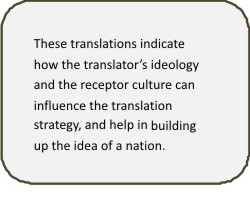Translations for the nation
The examples show how the translators were making use of the same text  to come up with translations that suited the receptor culture at a particular point of time. Aurobindo's translation in 1909 was meant to motivate his countrymen into militant political action. The differences in the translations of Aurobindo and Roy are indicating the change that Indian nationalist ideology had undergone.The nation-in-the-making was acutely conscious of the Hindu-Muslim divide and wanted to promote the ideal of secularism. By 2005 when Lipner translated the novel, postcolonialism had made its mark on literature and translation studies. It is a post-9/11 scenario where communal differences are a problem not just for India but also for the world as a whole. So Lipner's translation has a lot of paratext, with preface and introduction that places the text in context. It also tackles the issue of communal differences honestly. So the change we see is also a mirror of the change that has come over India – Aurobindo is not very sensitive to religious or cultural plurality, Roy is aware of the differences but cautious about mentioning anything that might worsen the situation and Lipner is similarly aware, but tries to celebrate the difference in a postmodern fashion. Thus we see how these translations contribute to the generally prevailing concept of the nation at different periods of time. to come up with translations that suited the receptor culture at a particular point of time. Aurobindo's translation in 1909 was meant to motivate his countrymen into militant political action. The differences in the translations of Aurobindo and Roy are indicating the change that Indian nationalist ideology had undergone.The nation-in-the-making was acutely conscious of the Hindu-Muslim divide and wanted to promote the ideal of secularism. By 2005 when Lipner translated the novel, postcolonialism had made its mark on literature and translation studies. It is a post-9/11 scenario where communal differences are a problem not just for India but also for the world as a whole. So Lipner's translation has a lot of paratext, with preface and introduction that places the text in context. It also tackles the issue of communal differences honestly. So the change we see is also a mirror of the change that has come over India – Aurobindo is not very sensitive to religious or cultural plurality, Roy is aware of the differences but cautious about mentioning anything that might worsen the situation and Lipner is similarly aware, but tries to celebrate the difference in a postmodern fashion. Thus we see how these translations contribute to the generally prevailing concept of the nation at different periods of time.
Assignments
- How have Anandamath and its translations contributed to the making of the nation?
- Keeping in mind all that you have read about equivalence and translation, what is your assessment of these various translations?
References:
Chatterji, Bankim Chandra. 1882. Anandamath. Trans. Aurobindo Ghosh. 1909.
http://www.sriaurobindoashram.org/ashram/sriauro/writings.php (accessed March 14, 2009)
Anandamath. Trans. Basanta Koomar Roy. 1941. 5th ed.2005: Delhi: Orient Paperbacks.
Anandamath. Trans. Julius Lipner. 2005. 2006 ed.:New Delhi: Oxford University Press.
Sarkar, Tanika. “Birth of a Goddess: Anandamath, Vande Mataram and Hindu Nationhood”. Economic & Political Weekly. Sep.16 in the Tanika Sarkar citation 2006: 3959 – 3969. |